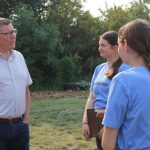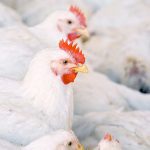Henia Martyniuk of Smoky Lake has been growing giant pumpkins for over 20 years. Her biggest pumpkin topped 337 pounds. “Pumpkin growing is a hobby, but it’s also a passion. People get involved because it’s a satisfying thing to do,” she says.
A giant pumpkin can expand up to 40 pounds a day in peak growing season. Some pumpkins have cracked when they grow too quickly. Martyniuk has tracked the progress of the pumpkin’s vine by fastening a clothespin to it. The clothespin will move throughout the day. “You can see the vine change in length. It can grow up to 16 inches in 24 hours,” she said. “Part of the fun of growing is the watching.”
Read Also

Farming Smarter receives financial boost from Alberta government for potato research
Farming Smarter near Lethbridge got a boost to its research equipment, thanks to the Alberta government’s increase in funding for research associations.
Eva Lewicki, another pumpkin grower from Smoky Lake, once grew a pumpkin that weighed 464 pounds. “It’s a lot of work, but also a lot of fun,” she says. The secrets to successful growing are seed, soil and sunshine. Pumpkins, which are actually fruit, need to be planted in soil that is one-third peat moss, one-third vermiculite and one-third pearlite. The mix can be bought and is often referred to as “soil-less soil.” If pumpkins are planted in heavy soil, they will often rot.
Martyniuk recommends planting giant pumpkins at least 10 feet apart. Vines around a pumpkin can grow as much as 70 feet in ideal conditions, she said.
The unique skin of pumpkins allows their growers to scar them. “If a pumpkin gets a scab or scratch on it, it will scab over and increase its size. Some growers etch their names into it, just like a brand,” says Martyniuk.
One of the secrets to growing big pumpkins is to start with seeds from another gigantic pumpkin. Many growers save the seeds from previous pumpkins and use them to grow new ones. Pumpkin seeds can cost as much as $30.
Lewicki said growers can get very attached to their giant pumpkins and will go to great lengths to protect them from frost, often wrapping them in quilts and extra bedding to keep them warm. “You’re freezing in bed and the pumpkin is warm,” she said.















